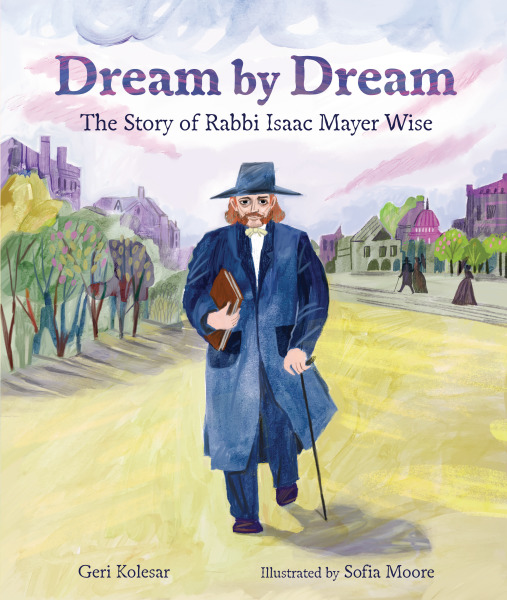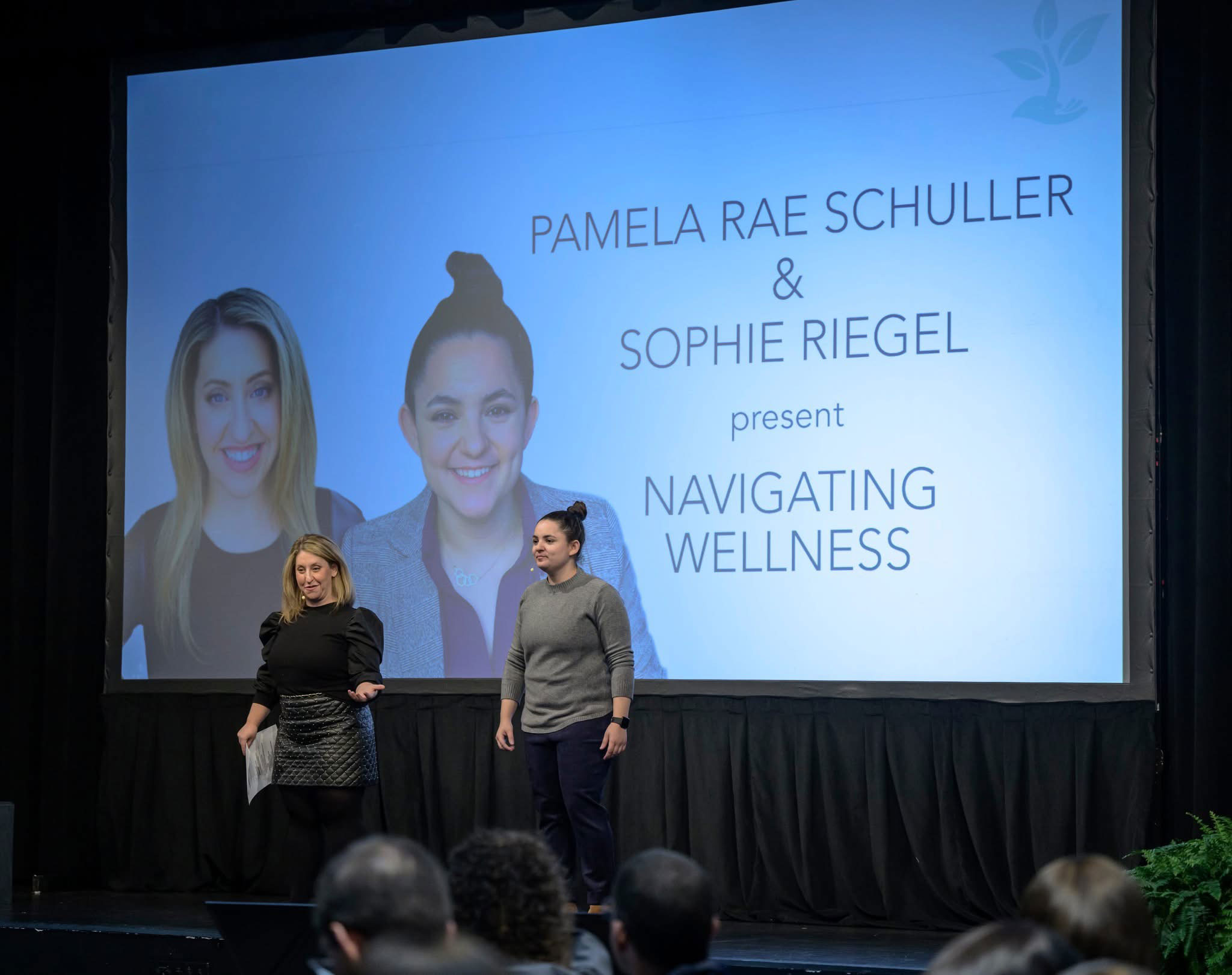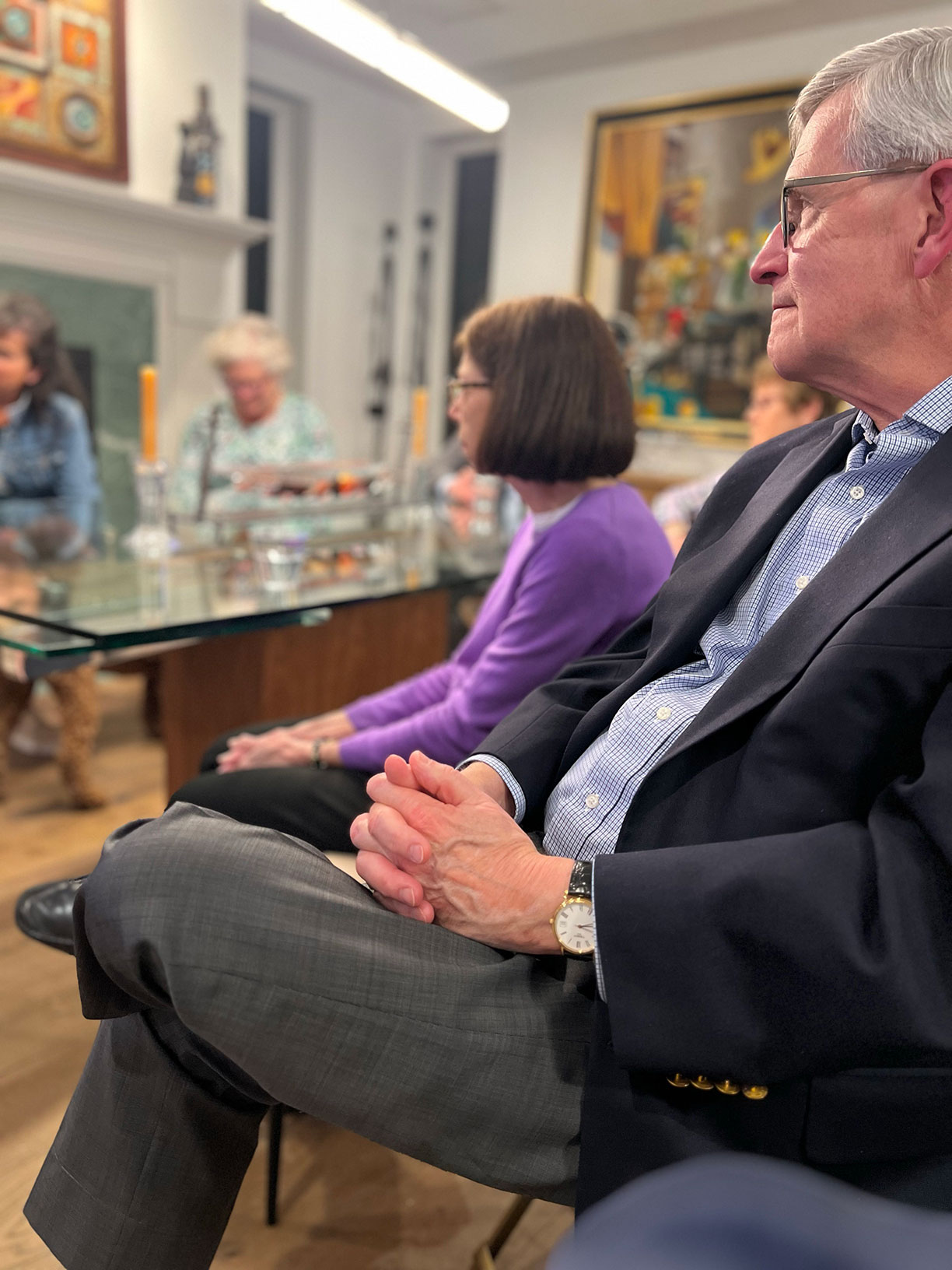By Julia Olson
Assistant Editor
There is no shortage of information about Isaac Mayer Wise, especially here in Cincinnati, where we are surrounded by the physical reminders of his long lasting contributions to Reform Judaism. These include Hebrew Union College, the famed Plum Street Temple and, of course, this very paper, The American Israelite. Stories about his work as the founder of Reform Judaism, a groundbreaking educator, organizer of the CCAR, and more, abound in our community. But, until now, knowledge of Isaac Mayer Wise is accessible primarily to adult audiences. If you’ve read his writing, you’re aware that he’s not necessarily a child-friendly author. Information about his childhood is also limited, leaving young audiences with little to relate to. However, Geri Kolesar wanted to bring Wise to a new generation, and began writing a book that would introduce young Isaac to young readers. That book, “Dream by Dream,” is the story of Rabbi Wise’s childhood. It is written for young audiences who, before now, likely had limited access to information about him. Rendering the life of such a complex thinker into something accessible for children is no easy feat. Despite that, Kolesar has delivered a masterful telling of Wise’s young life, imparting not only historical information to young readers but themes that prevailed in Wise’s life and shaped his thinking.
Before she began writing for young people, Kolesar taught environmental education to children, worked for a US Senator on Capitol Hill, and practiced law in Manhattan. After she had three children of her own, she transitioned to a new realm of work as a children’s author. She has written for both children and middle grade readers, but, until “Dream by Dream,” had focused on fiction writing. Her book on Rabbi Wise is the first time she’s worked with non-fiction material for young readers, and it came with its own set of challenges and delights. I was lucky enough to be able to chat with Kolesar and discuss the genesis of her book and her process for writing it.
JO: Did you encounter any challenges while working to make Dr. Wise’s life accessible to children? In other words, were there difficulties in translating the life and work of this complex man into a child-friendly narrative?
GK: The simple answer is a big YES. From the start, I knew it would be challenging to find a child-friendly angle for this story. Isaac Mayer Wise is indeed a complex man with countless far-reaching achievements. He is known for his erudite teachings and writings. He is also well known for the significant buildings and institutions he founded, many of which still today form the underlying structure for Reform Judaism of North America. But institutions, buildings and theological teachings aren’t exactly the fodder for sparking interest in young readers.
A simple way to enhance accessibility for little people was the choice to call him “Isaac” throughout the book, rather than the host of appropriate, more formal titles he earned.
Many picture book biographies capture children’s attention by highlighting interesting and formative aspects of the subject’s childhood. So, I figured something of interest would surely emerge once I read more about his childhood. Well, first off, there are no other books about him for young readers. And in the tomes written by and about him, there is little about his childhood. He apparently didn’t like talking about it.
So, I kind of worked backwards by first identifying common themes from his adult achievements. What struck me was his persistence and refusal to take no for an answer; his burning purpose and commitment to America and religious freedom; his ability to think outside the box and dream big. I scoured the scant chapters about his childhood spread across a few biographies and looked for “evidence” of those character traits when he was a little boy. Luckily, his grandson, Max Benjamin May, wrote a wonderful biography which contains some personal reflections on Isaac Mayer Wise’s youth. And James Heller, who succeeded Isaac Mayer Wise as rabbi of KK B’nai Yeshurun/Wise Temple, also wrote a comprehensive biography which includes some information about Wise’s youth. I chose anecdotes which when, taken together, captured a small boy with big goals who marched headstrong toward those goals, bolstered by his strong sense of fairness and justice. That formed the child-friendly foundation on which to build the story.
JO: Was there an element of his story you felt most fun or accessible for children?
GK: In general, most of us gravitate to stories about underdogs who persist and ultimately win. Children are no different. The first few sentences of the picture book give some historical context and reference how Jewish people were treated harshly in the part of Europe where young Isaac’s family lived. That is followed by a more personal story about how Isaac was beat up by the butcher’s son just for being Jewish. Isaac fought back and expected his father to be proud of him. Instead his father scolded him telling him he needed to use his words and not fists. What child can’t relate to feeling unfairly picked on, or wanting to please a parent and falling short?
Another example. Wise was an outside-the-box thinker. He understood the world was changing and that Judaism needed to keep pace with the times while not compromising its key pillars. Including in the book his then-revolutionary dream of girls studying alongside boys and women being equals in temple life seemed a good child-friendly way to illustrate this.
And just one more example. Young Isaac was a precocious student. At a young age, he was sent to live with his grandfather in a larger village with a more challenging school. He admired his learned grandfather and they developed a special, loving relationship until he died when Isaac was twelve. While it isn’t joyful to read about losing a beloved grandfather, keeping that element in the story accesses the relatable emotions all children experience at some level when they lose something they love — even a stuffed animal.
In all these vignettes, young Isaac “wins” of his own volition in ways that all children can feel empowered by. He sets out to read and learn as much as possible so he can fight back with his words. Despite losing his beloved grandfather, 12-year-old Isaac lifts his broken heart, tosses a few coins in his pocket and walks to Prague to become a rabbi. Stories arising from a place of hurt and loss are relatable. Hopefully together they will create in readers a desire to root for this young boy who, despite incredible adversity, persisted into adulthood to follow his dreams.
JO: What was your research process like when digging into Dr. Wise’s life? Where do you even begin? I would love to know more about your process. I cannot imagine what labor it must have been to dig through so much information about him and sift out the parts that would make a fun and compelling narrative for children. What did that process look like for you?
GK: “Where do you even begin?” More than once, I asked myself this very question. I am neither a historian nor an expert on Isaac Mayer Wise, so I feel extraordinarily grateful for the support and consistent guidance I received from Dr. Gary Zola, Rabbi Lewis Kamrass, Rabbi Karen Thomashow and Rabbi Ken Kanter. Those who know me know I have a persistent streak, too. Despite their busy schedules, these rabbis answered countless questions, pointed me to critical resources, and reviewed drafts of the manuscript for accuracy.
As for my process, I generally write fiction. I had no process for non-fiction. I have been lucky to be part of a critique group of talented local children’s book authors. Several write non-fiction and I always marveled at their work and their dedication to the research behind their stories. As for me, I am happy to invent my own characters and be accountable only to myself for their authenticity. For this story, I had the weight of capturing a story about a world-renowned historical figure, some would say the most important Jewish figure in American history. More than a bit intimidating.
I created a system by which I could keep track of each resource consulted and trace the sources for each fact used in the story. I have a legal background so devising that system came easily to me. The harder part was ferreting through reams of paper deciding what to use and what to toss. It all seemed important. And for good reason — it is.
Something I did that wasn’t exactly research, but more recovering from research or stalled inspiration, was visit his gravesite. I’m lucky it is so close by. I found it peaceful and inspiring to be literally standing at the foot of greatness.
So much is written by and about Isaac Mayer Wise that I never pretended I could read or understand it all. Your question gets to the heart of the biggest challenge of this project. With all of these resources on him, all the information about him and all of his accomplishments, what should be included in a children’s picture book about his life? And equally important, what could be said in just 1000 words? I quickly realized that I could not do justice to the whole of his life or accomplishments. Instead, I set my sights on writing something that might spark an interest in young readers, or those reading to them, to learn more about this amazing man, something that might inspire children to believe in themselves and their dreams.
JO: The illustrations in the book are so amazing. How did you come up with them with the illustrator? What sort of input do you, the author, have on that part of the creative process?
GK: I am extremely grateful that Kar-Ben Publishing selected Sofia Moore to illustrate this story. Her artwork elevates the story. Her illustrations are detailed, beautiful, and make the book come alive.
Unless you are both an author and professional illustrator, authors typically don’t have a big role in the illustration process. The publisher at Kar-Ben, Joni Sussman, generously included me at key steps along the way, first sharing Sofia’s rough sketches and later sketches, refined and modified based on our comments. Even having seen the final sketches, it was still exciting to see the artwork paired with the text once the whole book was assembled.
JO: What aspect of his life felt like it was essential to the story?
GK: His glasses. Not really, but sort of. This is a picture book story for children, illustrated by an artist’s interpretation. The characters and scenery are not meant to be exact depictions of reality. Sofia did a great job of making words on a page come to life in a child-friendly way. I wanted there to be one illustration that was at least loosely recognizable as the man familiar to us from the most popular photographs of him in his later years in Cincinnati. So, on the final illustration of him sitting at his desk, I requested that his characteristic glasses perched on his head be included. The publisher and illustrator kindly obliged.
JO: How long did this process, from start to finish, take you?
GK: Too long. Shortly after moving to Cincinnati, we joined Wise Temple thanks to the suggestion of Mike Oestreicher who was my husband’s law partner. Over the years, I occasionally talked about writing for children with Andrea Rapp, our temple librarian and herself an expert on Isaac Mayer Wise. In one of our conversations, Andrea pointed out to me that there were no children’s books about this amazing man. Didn’t he deserve a place on the children’s bookshelf?
At that point, I had been a member of Wise Temple for quite a while and had already served as an officer and trustee on the temple board for many years. My three children attended religious school and we celebrated many life cycle events there. So I had been saying his name for a long time. But, truth be told, I had no idea the full spectrum of his contributions to Reform Judaism until preparing to write this book.
There were times I tried NOT to write this book, placing half written pages and partially read articles in a firmly closed drawer. But then I would start reading again and the more I learned, the more I became inspired to create a child-friendly way to celebrate him and what is unique about Reform Judaism. I know it sounds corny, but sometimes it was Rabbi Wise’s indefatigable pursuit of his dreams despite personal, professional, and societal obstacles across a lifetime that inspired me to keep trying to pull a story together.
I could have kept writing and rewriting. There was always something new to include or exclude. The process began years ago with Andrea’s suggestion and it ended with a friend and established author, Linda Leopold Strauss, gently — and eventually not so gently — prodding me to submit the manuscript, already!
Once I started working with Kar-Ben, it was about two years until the book was released in August of this year.
Kolesar’s book also comes with a free educator’s guide, which can be downloaded from her website. The guide was the product of more of Kolesar’s research that did not fit into the book. The amount of material was “probably ten times the length of the story itself,” she says. Kar-Ben, the book’s publisher, encouraged Kolesar to use the extra material to make a guide for educators that accompanies the book. Kolear says, “Lucky for me, seasoned educator Barbara Dragul, who I knew from her years directing education and lifelong learning at Wise Temple, agreed to partner in developing a guide. Our overarching goal was to supplement the book with an Educator Guide that would make it easy for adults to share in a child-friendly way the rich and important roots of American Reform Judaism. I hope we created a meaningful resource for curious minds of all ages and, most especially, for overworked teachers trying hard every day to make a difference.
Courtney Anthony, the current Director of Education at Wise Temple, has put the Guide into action to incorporate the book into the Wise Temple religious school curriculum for grades 3-6. I’m excited to see this come to fruition for the first time in the next few weeks. Hopefully it will serve as a model for other schools, religious and secular, that want to bring to life for young readers one of the most important Jewish figures in American history.”
Kolesar’s book is a testament to Isaac Mayer Wise’s impact in Cincinnati and across the country. Kolesar and her family are members at Wise, and her love for that community is made even clearer by her choice to donate all author proceeds from the book to the Plum Street Temple Historic Preservation Fund. “I am thankful for the Cincinnati congregation Isaac Mayer Wise built, and which welcomed my interfaith family with open arms. I can’t have an interview about Isaac Mayer Wise or this book without mentioning Plum Street Temple. When the doors first opened in 1866, there were fewer than 200 members in Rabbi Wise’s congregation. Yet the temple was built to seat over 1000 people. I like to think those extra pews were his way of welcoming future generations,” says Kolesar. “Dream By Dream” is certainly Kolesar’s way of bringing Isaac Mayer Wise to those future generations, the very ones for whom he built those pews.





